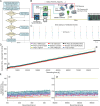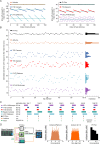Syntalos: a software for precise synchronization of simultaneous multi-modal data acquisition and closed-loop interventions
- PMID: 39814800
- PMCID: PMC11736130
- DOI: 10.1038/s41467-025-56081-9
Syntalos: a software for precise synchronization of simultaneous multi-modal data acquisition and closed-loop interventions
Abstract
Complex experimental protocols often require multi-modal data acquisition with precisely aligned timing, as well as state- and behavior-dependent interventions. Tailored solutions are mostly restricted to individual experimental setups and lack flexibility and interoperability. We present an open-source, Linux-based integrated software solution, called 'Syntalos', for simultaneous acquisition and synchronization of data from an arbitrary number of sources, including multi-channel electrophysiological recordings and different live imaging devices, as well as closed-loop, real-time interventions with different actuators. Precisely matching timestamps for all inputs are ensured by continuous statistical analysis and correction of individual devices' timestamps. New data sources can be integrated with minimal programming skills. Data is stored in a comprehensively structured format to facilitate pooling or sharing data between different laboratories. Syntalos enables precisely synchronized multi-modal recordings as well as closed-loop interventions for multiple experimental approaches. Preliminary neuroscientific experiments on mice with different research questions show the successful performance and easy-to-learn structure of the software suite.
© 2025. The Author(s).
Conflict of interest statement
Competing interests: The authors declare no competing interests.
Figures






References
-
- Jensen, H. J. Self-Organized Criticality: Emergent Complex Behavior in Physical and Biological Systems (Cambridge University Press, 1998).
-
- Asth, L., Lobão-Soares, B., André, E., Soares, V. D. P. & Gavioli, E. C. The elevated T-maze task as an animal model to simultaneously investigate the effects of drugs on long-term memory and anxiety in mice. Brain Res. Bull.87, 526–533 (2012). - PubMed
MeSH terms
Grants and funding
LinkOut - more resources
Full Text Sources
Other Literature Sources

